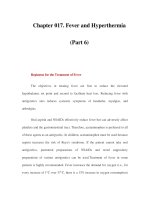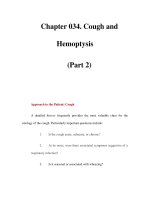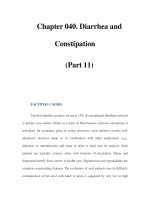Chapter 071. Vitamin and Trace Mineral Deficiency and Excess (Part 6) ppsx
Bạn đang xem bản rút gọn của tài liệu. Xem và tải ngay bản đầy đủ của tài liệu tại đây (11.23 KB, 5 trang )
Chapter 071. Vitamin and Trace Mineral
Deficiency and Excess
(Part 6)
Toxicity
The safe upper limit for vitamin B
6
has been set at 100 mg/d, although no
adverse effects have been associated with high intakes of vitamin B
6
from food
sources only. When toxicity occurs, it causes a severe sensory neuropathy, leaving
patients unable to walk. Some cases of photosensitivity and dermatitis have also
been reported.
Folate, Vitamin B
12
See Chap. 90.
Vitamin C
Both ascorbic acid and its oxidized product dehydroascorbic acid are
biologically active. Actions of vitamin C include antioxidant activity, promotion
of nonheme iron absorption, carnitine biosynthesis, the conversion of dopamine to
norepinephrine, and the synthesis of many peptide hormones.
Vitamin C is also important for connective tissue metabolism and cross-
linking (proline hydroxylation), and it is a component of many drug-metabolizing
enzyme systems, particularly the mixed-function oxidase systems.
Absorption and Dietary Sources
Almost complete absorption of vitamin C occurs if <100 mg is
administered in a single dose; however, only 50% or less is absorbed at doses >1
g. Enhanced degradation and fecal and urinary excretion of vitamin C occur at
higher intake levels.
Good dietary sources of vitamin C include citrus fruits, green vegetables
(especially broccoli), tomatoes, and potatoes. Consumption of five servings of
fruits and vegetables a day provides vitamin C in excess of the RDA, 90 mg/d for
males and 75 mg/d for females. In addition, approximately 40% of the U.S.
population consumes vitamin C as a dietary supplement in which "natural forms"
of vitamin C are no more bioavailable than synthetic forms. Smoking,
hemodialysis, pregnancy, and stress (e.g., infection, trauma) appear to increase
vitamin C requirements.
Deficiency
Vitamin C deficiency causes scurvy. In the United States, this is seen
primarily among the poor and elderly, in alcoholics who consume <10 mg/d of
vitamin C, and also in individuals consuming macrobiotic diets. In addition to
generalized fatigue, symptoms of scurvy primarily reflect impaired formation of
mature connective tissue and include bleeding into skin (petechiae, ecchymoses,
perifollicular hemorrhages); inflamed and bleeding gums; and manifestations of
bleeding into joints, the peritoneal cavity, pericardium, and the adrenal glands.
In children, vitamin C deficiency may cause impaired bone growth.
Laboratory diagnosis of vitamin C deficiency is made on the basis of low plasma
or leukocyte levels.
Administration of vitamin C (200 mg/d) improves the symptoms of scurvy
within a matter of several days. High-dose vitamin C supplementation (e.g., 1–2
g/d) might slightly decrease the symptoms and duration of upper respiratory tract
infections.
Vitamin C supplementation has also been reported to be useful in Chédiak-
Higashi syndrome (Chap. 61) and osteogenesis imperfecta (Chap. 357).
Diets high in vitamin C have been claimed to lower the incidence of certain
cancers, particularly esophageal and gastric cancers. If proved, this effect may be
due to the fact that vitamin C can prevent the conversion of nitrites and secondary
amines to carcinogenic nitrosamines. However, one intervention study from China
did not show vitamin C to be protective.
Toxicity
Taking >2 g of vitamin C in a single dose may result in abdominal pain,
diarrhea, and nausea. Since vitamin C may be metabolized to oxalate, it is feared
that chronic, high-dose vitamin C supplementation could result in an increased
prevalence of kidney stones.
However, this has not been borne out in several trials, except in patients
with preexisting renal disease. Thus, it is reasonable to advise patients with a past
history of kidney stones to not take large doses of vitamin C.
There is also an unproven but possible risk that chronic high doses of
vitamin C could promote iron overload in patients taking supplemental iron. High
doses of vitamin C can induce hemolysis in patients with glucose-6-phosphate
dehydrogenase deficiency, and doses >1 g/d can cause false-negative guaiac
reactions as well as interfere with tests for urinary glucose.









